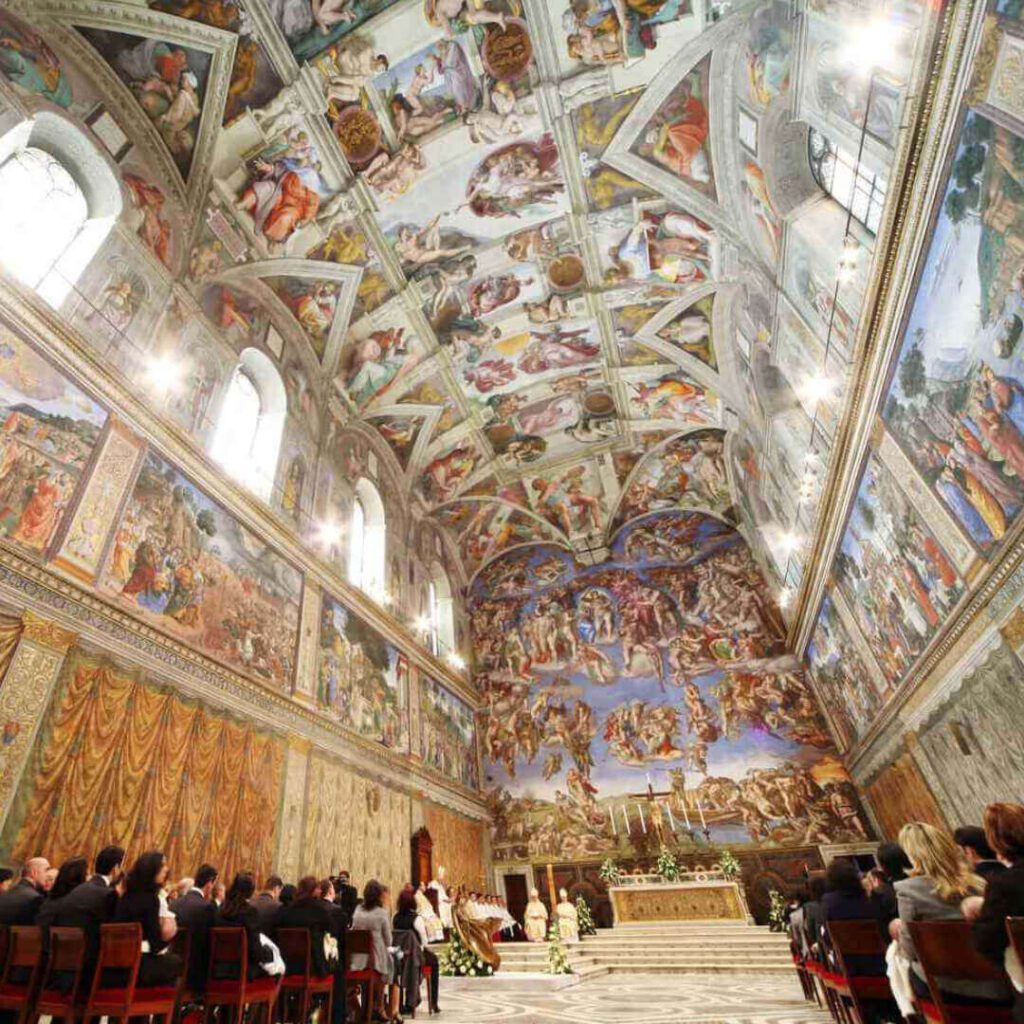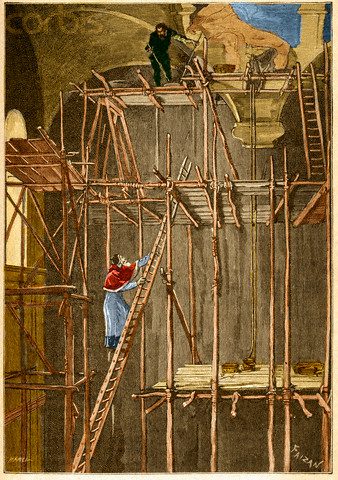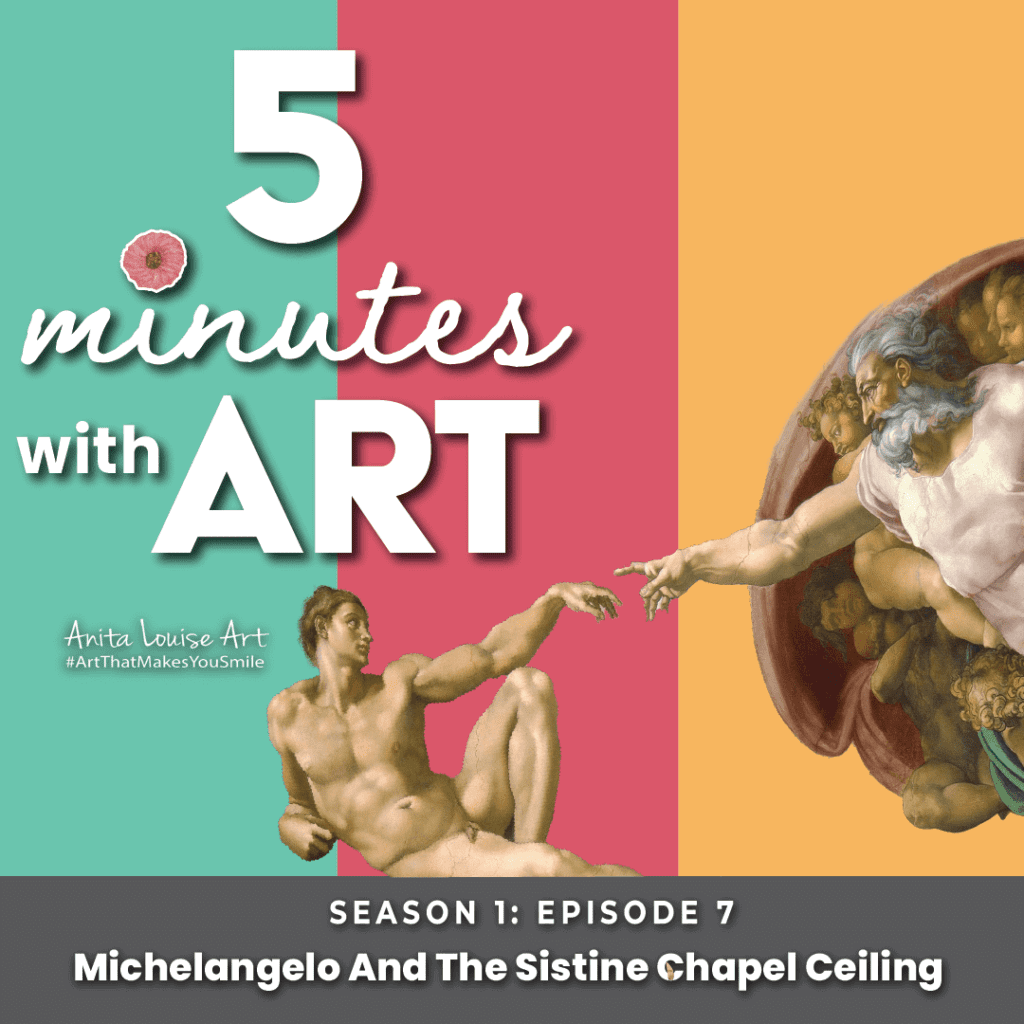When most people think about Michelangelo, they think about his statue of David and the ceiling of the Sistine Chapel. Artists are in awe of his ability to paint such a magnificent work of art on a ceiling.
Michelangelo used the fresco method to paint the Sistine Chapel ceiling. The fresco method is when you apply plaster and paint to the ceiling. It is very tedious and challenging work, especially on a ceiling. Michelangelo built a large scaffolding structure that he could move around the chapel to paint the Sistine Chapel ceiling. The painting was highly strenuous work that came at a substantial personal cost, both physically and mentally, to Michelangelo.
Table of Contents
- Michelangelo’s And The Sistine Chapel
- Michelangelo’s Method To Paint The Sistine Chapel Ceiling
- Personal Cost To Michelangelo Due To The Sistine Ceiling Work
- Frequently Asked Questions
- Related Questions
Michelangelo’s And The Sistine Chapel
When you view Michelangelo’s fantastic work for the Sistine Chapel, it is a wonder that such exquisite work could be done on the ceiling.
When Michaelangelo painted the ceiling, there was artwork by other artists around the chapel, but the ceiling was only painted a simple blue to match the color of the sky, and some painted stars were scattered on the ceiling.
The Sistine Chapel Commission
In the early 16th Century, Michelangelo was already a well-known artist because David’s statue was a great success. He had an excellent artist reputation for being able to paint and sculpt life-like anatomical figures for his statues and paintings.

Michelangelo was already a favorite artist of Pope Julius, so he had access to both the Pope and the Vatican. Given Michelangelo’s reputation and access to the Pope, there was no surprise that he was given the commission to paint the ceiling of the Sistine Chapel. The chapel walls were already adorned with frescoes by Botticelli Ghirlandaio, Perugino, and other famous artists.
We know Michelangelo was a favorite of the Pope because, despite the fact he had minimal experience working with fresco painting, he was still given this lucrative and essential commission. He was best known as a sculptor, yet the Pope entrusted him with such an important fresco painting commission.
The Preliminary Work For The Sistine Chapel Commission
The Pope thought that Michelangelo should depict the twelve apostles on the ceiling. But Michelangelo had bigger plans and wanted to paint several intricate scenes instead.
Michelangelo rose to the task of painting the chapel ceiling. He was not an expert on the fresco technique, so he invited his artist friends from Florence to Rome to show him how to paint using the fresco technique.
He also realized that he wanted to do something grand with the chapel’s ceiling. He locked himself away in the chapel and started sketching. He began to work using trial and error to decide what and how to paint the chapel.
His first design was simple, probably something more of what the Pope had initially asked for of the twelve apostles with some filler decoration around them. But for Michelangelo, that did not seem right for the ceiling and the space.

He then started to design something more ambitious and grander, which is the design of the ceiling that we have today.
Michelangelo was to paint over 300 different figures on the chapel ceiling. The preparatory work alone for the chapel was to take several months. He stated on the preliminary drawings in April 1508 and did not complete the design until late July 1508.
Michelangelo’s Method To Paint The Sistine Chapel Ceiling
To paint a ceiling is challenging, and painting it in the 16th Century must have been highly problematic. To reach the chapel ceiling, Michelangelo had to create special scaffolding.
We must remember that Michelangelo was by all accounts a sculptor and fresco painting on a ceiling, was not his expertise. Painting such an intricate piece of art on a ceiling proved highly strenuous.
Michelangelo’s Special Scaffolding

Image by © Stefano Bianchetti/Corbis
Michelangelo’s scaffolding was specially built to remove the strain of the work and allow the artwork to be completed as quickly as possible. The scaffolding was built with brackets secured with holes in the walls.
Creating the scaffolding allowed the scaffolding to move around the room. When he completed the painting of one section, he could transfer the scaffolding across to another part of the chapel.
The scaffolding allowed Michelangelo to get about 60 feet in the air and close to the ceiling. Even with the scaffolding in place, he still had to strain and exert himself to do the painting.
Michelangelo Applied Washes Of Paint, Plaster, And Paint
Michelangelo applied washes of paint to the wet plaster for the fresco technique of painting.
Michelangelo would mix sand and lime for the painting method and then spread the mixture over the ceiling. Next, they would apply the colors, which he would need to do quickly while the plaster mixture was still wet.
If the color were added when the plaster mixture was dry, the colors would fuse chemically with the lime and become permanent.
The fresco method was not easy to master but once mastered, the results of what the artist could create were stunning, and the work and painting would last for a very long time.
To create an illusion of depth, Michelangelo would scrape off some of the wet mediums before painting to make some outlines. His method created some visible outlines around his figures; it is a detail unique to Michelangelo and his painting style.

Listen To Our Podcast About Michelangelo And The Sistine Chapel Ceiling below or by clicking here.
Personal Cost To Michelangelo Due To The Sistine Ceiling Work
Many people do not realize the high personal cost to Michelangelo’s mental and physical health and the tremendous strain it caused him to do the work on the Sistine Chapel ceiling. The work was challenging and strenuous.
Working the ceiling, Michelangelo was constantly stretching and straining his neck to reach the canvas. And despite the special scaffolding that he created, he could not complete the work without using extreme exertion.
Every day Michelangelo would need to mix up the plaster and then use a trowel to put it up the scaffolding to the ceiling. Then he was under pressure to work very quickly to paint his subject matter before the plaster dried.
Physically it was highly strenuous work for even the fittest artist. He would have had to lift, apply and paint everything above his head, all while working 60 or more feet above the ground.
He did not just do this for a short time to paint the Sistine ceiling, but the painting of the ceiling took him four years to paint. So daily for over four years, Michelangelo was putting his body under stress and strain.
Working that close to the ceiling and in what must have been not very good light also caused a tremendous strain on Michelangelo’s eyes and ruined his eyesight. For the rest of his life, Michelangelo suffered from poor vision due to the stress on his eyes while working on the Sistine Chapel Ceiling.
Frequently Asked Questions
How did Michelangelo prepare the surface for painting the Sistine Chapel ceiling?
Michelangelo used the fresco method, which involves applying plaster and paint directly to the ceiling. This technique required careful preparation of the surface before the actual painting could begin.
What is the fresco method, and why did Michelangelo choose it for the Sistine Chapel ceiling?
The fresco method involves painting on wet plaster, allowing the pigments to be absorbed into the surface as it dries. Michelangelo chose this method for its durability and ability to create vibrant and long-lasting colors.
Why was painting the Sistine Chapel ceiling considered a challenging task?
Painting a ceiling is inherently challenging, and Michelangelo’s Sistine Chapel project was particularly demanding due to the physical and mental toll it took. The artist had to work for extended periods in an uncomfortable position, contributing to the difficulty of the task.
How did Michelangelo overcome the challenges of painting the Sistine Chapel ceiling?
To address the challenges of painting the ceiling, Michelangelo constructed a large scaffolding structure that he could move around the chapel. This innovative solution allowed him to reach different areas of the ceiling without compromising the quality of his work.
What was the personal cost to Michelangelo in painting the Sistine Chapel ceiling?
The creation of the Sistine Chapel ceiling took a toll on Michelangelo’s physical and mental well-being. The strenuous nature of the work, combined with the extended duration of the project, had a significant personal cost for the artist.
How did Michelangelo’s use of the fresco method contribute to the longevity of the Sistine Chapel ceiling?
The fresco method, with its integration of pigments into wet plaster, contributed to the longevity of the Sistine Chapel ceiling. This technique ensured that the colors would remain vibrant and the artwork would withstand the test of time.
Were there specific challenges associated with painting a fresco on a ceiling as opposed to a vertical surface?
Painting on a ceiling presented unique challenges, such as the need to work overhead for extended periods. Michelangelo’s ingenuity in designing a movable scaffold helped overcome these challenges and allowed him to achieve the desired artistic vision.
What inspired Michelangelo to undertake the monumental task of painting the Sistine Chapel ceiling?
Michelangelo was commissioned by Pope Julius II to paint the Sistine Chapel ceiling. The inspiration behind the project was rooted in religious and artistic motivations, with the intent to create a masterpiece that would inspire awe and reverence.
How did Michelangelo’s artistic skills contribute to the success of the Sistine Chapel ceiling?
Michelangelo’s exceptional artistic skills, including his mastery of anatomy, perspective, and composition, played a crucial role in the success of the Sistine Chapel ceiling. His ability to translate complex themes onto a curved surface is regarded as a testament to his genius.
What impact did Michelangelo’s work on the Sistine Chapel ceiling have on the world of art and future generations of artists?
The Sistine Chapel ceiling is considered one of the greatest achievements in Western art. Michelangelo’s innovative techniques and unparalleled artistic vision set new standards for future generations of artists, influencing the course of art history.
Anita Louise Art is dedicated to art education, great artists, and inspiring others to find and create their art. We love art that uplifts and inspires. #ArtToMakeYouSmile! #ArtToMakeYouHappy!
If you are interested in seeing any of my art, you can find out more by clicking here. If you are interested in what inspires me and my paintings, you can discover more by clicking here.
We have a free newsletter and would love you to be part of our community; you can subscribe to the newsletter by clicking here. If you have any questions, I would be happy to talk to you. You can reach me, Anita, by clicking here.
Subscribe to our Anita Louise Art YouTube Channel filled with great videos and information by clicking here.
Join us for our podcast “5 Minutes With Art.” Spend just 5 minutes a week with us to discover and learn about great art and artists. You can find out more about our podcast by clicking here.
Related Questions
Did Michelangelo And Leonardo Know Each Other?
Michelangelo and Leonardo da Vinci knew each other but were considered bitter rivals. Leonardo da Vinci and Michelangelo knew each other, but they did like each other. They were both asked to do a commission on the Council Hall of the Palazzo Vecchio and were supposed to work side-by-side; the project was never completed.
By clicking here, you can learn more by reading Did Michelangelo And Leonardo Know Each Other?.
What Was The Focus Of Renaissance Art?
The focus of Renaissance art was on the classics of Greek and Rome, humanist philosophy, and the study of the human figure. Realism was also an essential part of renaissance art. The great artists of the Renaissance also became great anatomists and studied human beings.
By clicking here, you can learn more by reading What Was The Focus Of Renaissance Art?.
Michelangelo’s Sistine Chapel And His Payment
Michelangelo was paid 3200 gold ducats for his work on the ceiling of the Sistine Chapel, which would have been a very lucrative commission. We know that he stopped work on the ceiling for a while due to his not being paid by the Vatican. Michelangelo liked to give the impression that he was a very poor artist, but records have shown that he died an extremely wealthy man.
By clicking here, you can learn more by reading Michelangelo’s Sistine Chapel And His Payment.

